This post may contain affiliate links. Please read our disclosure policy.
Zalabia is a Middle Eastern sweet fried dough. My traditional Lebanese zalabia recipe makes little donut-hole puffs spiced with anise and cinnamon. They glisten with the glaze of an aromatic syrup made with rose and orange blossom water, a favorite flavoring in Lebanese cuisine!
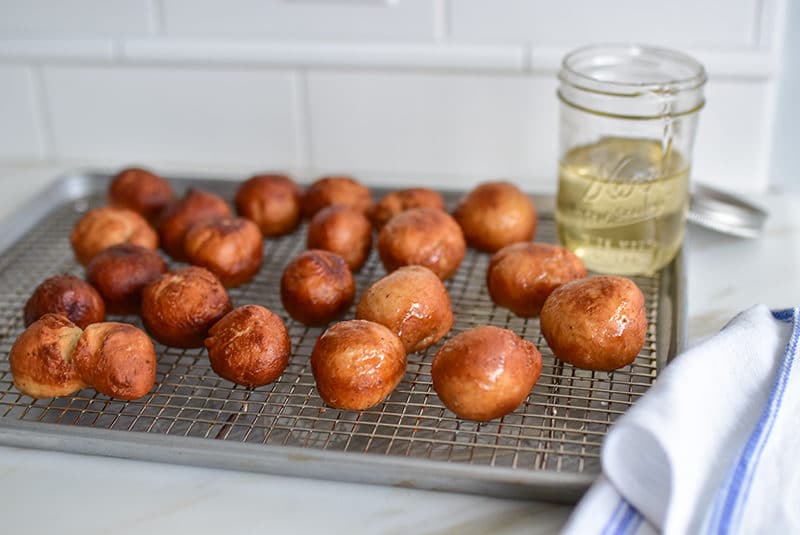
Ingredients
- Active dry yeast
- Warm water – about 105 degrees
- Unbleached all-purpose flour
- Granulated sugar
- Kosher salt
- Spices – ground anise seed and cinnamon
- Oil – canola oil or another neutral oil to coat the bowl and for frying
- Lemon juice
- Rose water
- Orange blossom water
Instructions
How to Make the Simple Syrup
Step 1: In a small saucepan, combine sugar, water, and lemon juice and bring to a boil over medium-high heat. Reduce heat to low and simmer for 5 minutes.
Step 2: Remove from the heat and add the orange blossom water and rose water (measure away from the pan so spills don’t happen in your syrup!).
Step 3: Pour the sugar syrup into a heatproof container and refrigerate to chill completely.
How to Make Zalabia
Step 1: Use a stand mixer fitted with the dough hook, or mix by hand. In a small bowl, mix the yeast with 1/4 cup of the warm water and 1 tablespoon of the sugar. Let this stand until it is creamy and a bit bubbly, about 10 minutes.
Step 2: In a large bowl or the bowl of the stand mixer, combine the flour, remaining sugar, salt, anise, and cinnamon. Add the proofed yeast mixture and mix by hand, or with the dough hook on the mixer, slowly adding the remaining water. Knead until the dough is smooth, sticky, and soft.
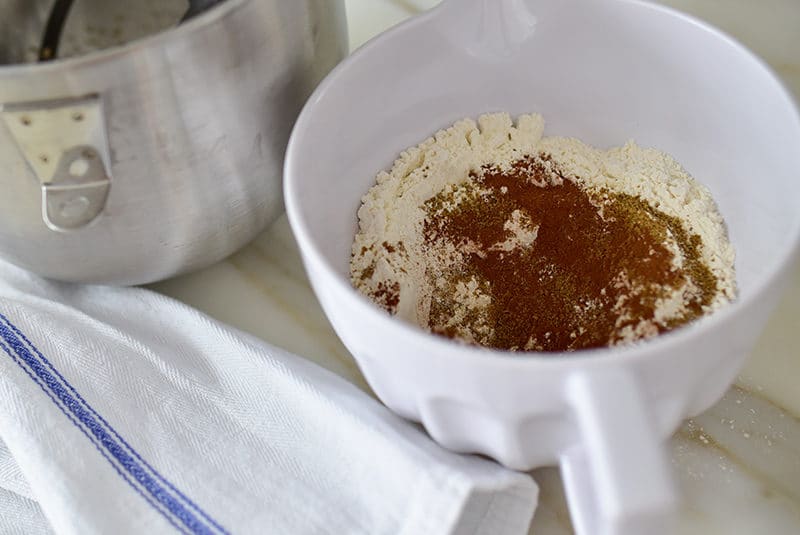
Step 3: In another medium bowl, coat the interior of the bowl with a teaspoon of oil. Place the dough in the bowl, coating the dough ball with the oil. Cover the bowl with plastic wrap (without touching the dough with it), cover that with a kitchen towel, and set aside to rise in a warm place for 90 minutes.
Step 4: Deflate the risen dough, cover again with the plastic wrap and towel, and let the dough rise again for 30 minutes.
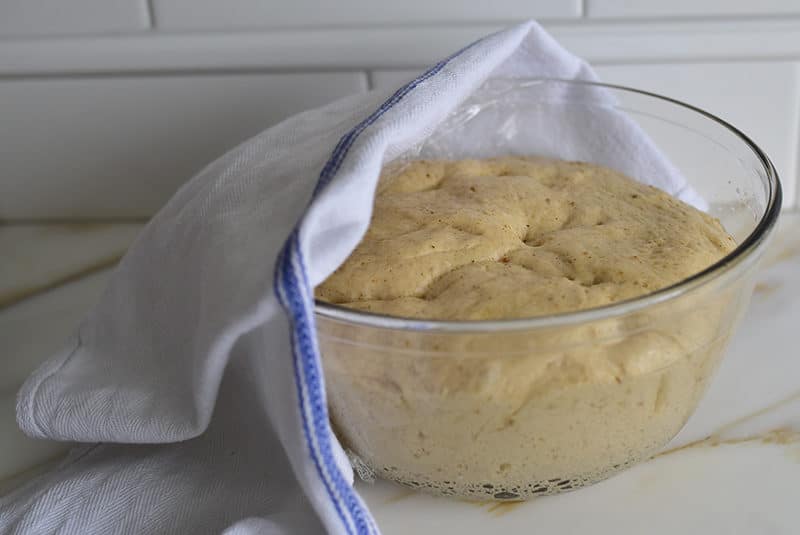
Step 5: Fill a nonstick frying pan to about an inch high with oil. Heat over medium heat to 370 to 375 degrees.
Step 6: Pull off walnut-sized pieces of dough and shape them into balls using the palm of your hands. Place the balls on a lightly floured sheet pan or large tray. The shape of the balls doesn’t have to be perfect!
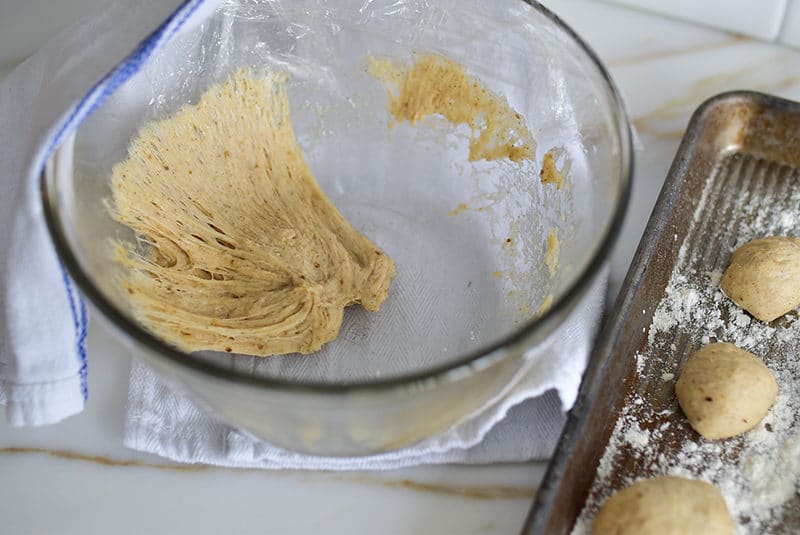
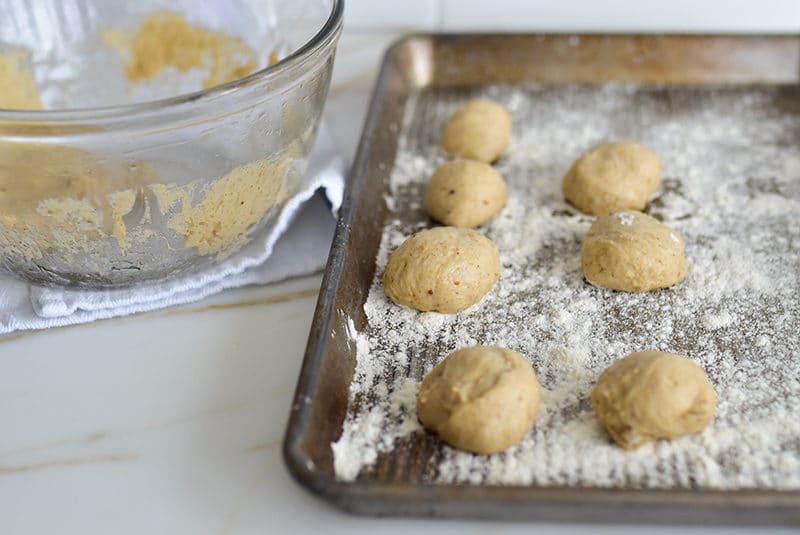
Step 7: Set up a rack over a sheet pan next to the frying pan. Fry several balls at a time, taking care to cook them through before browning the exterior by adjusting the heat down as needed. Flip the balls over with a slotted spoon, then remove them when they are golden brown all over and place them on the rack.
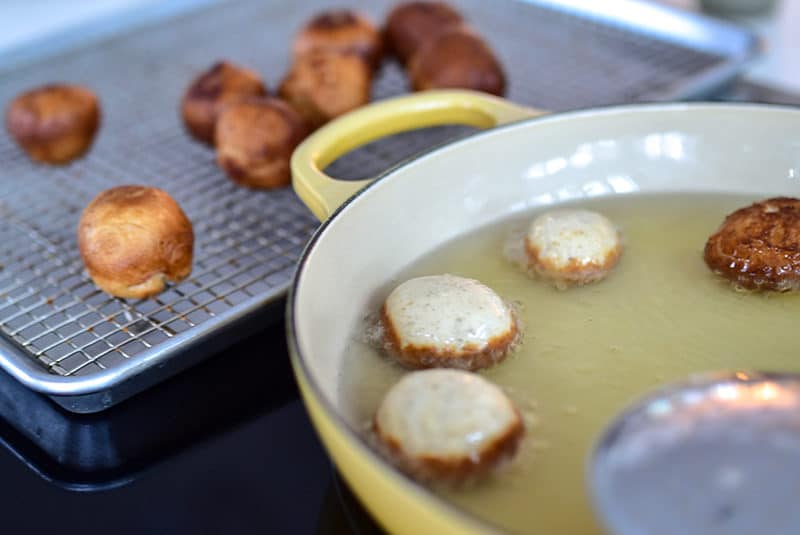
Step 8: To glaze the donuts, pour the cold syrup over the warm donuts, or dip the donuts in the syrup. Serve immediately with additional syrup for dipping.
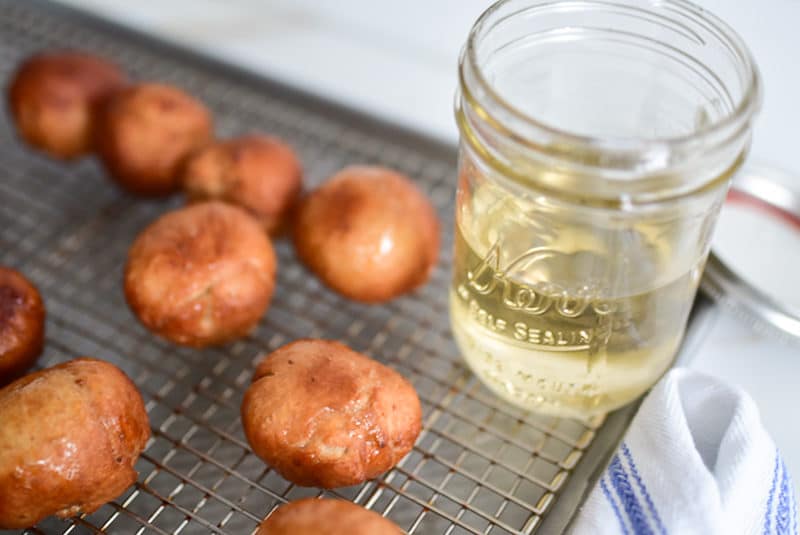
Expert Tips and Variations
- Make it kid-friendly. In my experience, if you want the children to love these, you better leave the anise out and only flavor the dough with cinnamon.
- Switch up the flower water. Although the combination of rose water and orange blossom water is truly irresistible, you can also use one or the other. Or, if you’re really not a fan of floral flavors, omit them both. Substitute other flavors if you like, such as vanilla, banana, coconut, or lemon extract.
- Finish with confectioners’ sugar. Instead of glazing the donuts with syrup, dust them with confectioners’ sugar.
- Finish with cinnamon sugar. Go traditional donut-style by rolling the just-fried donuts in a combination of granulated sugar (1 cup) whisked together with ground cinnamon (1 tablespoon).
- We also make zalabia with “leftover” dough on baking days and dust them with sugar (find that recipe here).
Make Ahead
Like any fried dough, zalabia is best when fresh. However, if you want to make this recipe ahead of time, do that with the dough. Make the dough all the way through to just before the first rise. Refrigerate the dough, in an oiled bowl covered with plastic wrap, for up to two days. To finish the donuts, bring the dough to room temperature and when it rises to double in size (or if already doubled, simply bring to room temperature), proceed with deflating and on to the second rise, shaping of the balls, frying, and glazing.

FAQs
Zalabia is a Middle Eastern yeasted, fried sweet that is made in two traditional ways: as a raised dough fried as a donut or as a yeasted batter that is drizzled and fried like a fritter. My recipe for these traditional Lebanese donuts is made with a yeasted dough, spiced with anise and cinnamon, and glazed with flower water syrup. They are made by Christian Lebanese to celebrate the feast of the Epiphany in January, but we love them whenever we want homemade donuts.
Zalabia, also called zalabya, zalabiyeh, lugaimat, or luqaimat, is found in Arabic countries and West Asia. It’s popular among many countries and was even the precursor to the popular South Asian snack, jalebi.
Although visually similar and related, the difference comes in their ingredients. The jalebi dough often includes corn or chickpea flour and yogurt, and is commonly flavored with cardamom, saffron, and rose water. On the other hand, zalabia is often flavored with anise, lemon, and rose or orange blossom water.
Zalabia tastes like a classic delicious yeasted donut hole with notes of anise and cinnamon. The syrup takes it over the top with its floral notes thanks to the rose water and orange-blossom water. Combined with the crisp yet fluffy texture, these Lebanese sweet fritters are truly irresistible!
Zalabia is far better in texture and flavor when fried. That said, to bake them, simply coat each dough ball with a light brush or spray of oil and bake in the oven at 350°F. They will bake up more like a roll than a donut, but they can still take a dip or a drizzle with the glaze.
More Middle Eastern Recipes
- Try another beloved Lebanese yeasted dough recipe, Za’atar Man’oushe flatbread
- Give garlic knots a twist with Garlic Knots with Za’atar
- Traditional yeasted Easter treats also include anise and other spices in my Lebanese Kaik Recipe
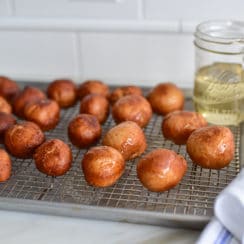
Zalabia Recipe
Ingredients
For the Syrup:
- 1½ cups granulated sugar
- ¾ cups water
- 1 tablespoon lemon juice
- ½ teaspoon rose water
- 1½ teaspoons orange blossom water
For the Zalabia:
- 1 tablespoon active dry yeast
- 1 cup warm water (about 105 degrees)
- 2 cups unbleached all-purpose flour
- ½ cup granulated sugar
- ¼ teaspoon kosher salt
- 1 tablespoon ground anise
- ¼ teaspoon cinnamon
- 1 teaspoon canola or safflower oil, for the bowl
- Canola or safflower oil, for frying
Instructions
For the syrup:
- In a small heavy saucepan, combine sugar, water and lemon juice and bring to a boil over medium high heat. Reduce heat to low and simmer for 5 minutes.
- Remove from the heat and add the orange blossom water and rose water (measure away from the pan so spills don’t happen in your syrup!).
- Pour the syrup into a heatproof container and refrigerate to chill completely.
For the Zalabia:
- Use a stand mixer fitted with the dough hook, or mix by hand. In a small bowl, mix the yeast with 1/4 cup of the warm water and 1 tablespoon of the sugar. Let this stand until it is creamy and a bit bubbly, about 10 minutes.
- In a large bowl or the bowl of the stand mixer, combine the flour, remaining sugar, salt, anise, and cinnamon. Add the proofed yeast and mix by hand, or with the dough hook on the mixer, slowly adding the remaining water. Knead until the dough is smooth, sticky, and soft.
- In another medium bowl, coat the interior of the bowl with the teaspoon of oil. Place the dough in the bowl, coating the ball of dough with the oil. Cover the bowl with plastic wrap (without touching the dough with it), cover that with a kitchen towel, and set aside to rise in a warm spot for 90 minutes.
- Deflate the risen dough, cover again with the plastic wrap and towel, and let the dough rise again for 30 minutes.
- Fill a nonstick frying pan to about an inch high with oil. Heat over medium heat to 370 to 375 degrees.
- Pull off walnut-sized pieces of dough and shape them into balls. Place the balls on a lightly floured sheet pan. The shape of the balls don’t have to be perfect!
- Set up a rack over a sheet pan next to the frying pan. Fry several balls at a time, taking care to cook them through before the exterior is browned by adjusting the heat down as needed. Flip the balls over with a slotted spoon, then remove them when they are golden brown all over and place them on the rack.
- To glaze the donuts, pour the cold syrup over the warm donuts, or dip the donuts in the syrup. Serve immediately with additional syrup for dipping.
Notes
Make Ahead Tips
Like any fried dough, zalabia is best eaten fresh. However, if you want to make this recipe ahead of time, do that with the dough. Make the dough all the way through to just before the first rise. Refrigerate the dough, in an oiled bowl covered with plastic wrap, for up to two days. To finish the donuts, bring the dough to room temperature and when it rises to double in size (or if already doubled, simply bring to room temperature), proceed with deflating and on to the second rise, shaping of the balls, frying, and glazing.Storage
Any leftover zalabia should be stored in an airtight container at room temperature. If they become too damp, simply allow them to rest uncovered for a short time before serving.Nutrition
Nutrition information is automatically calculated, so should only be used as an approximation.
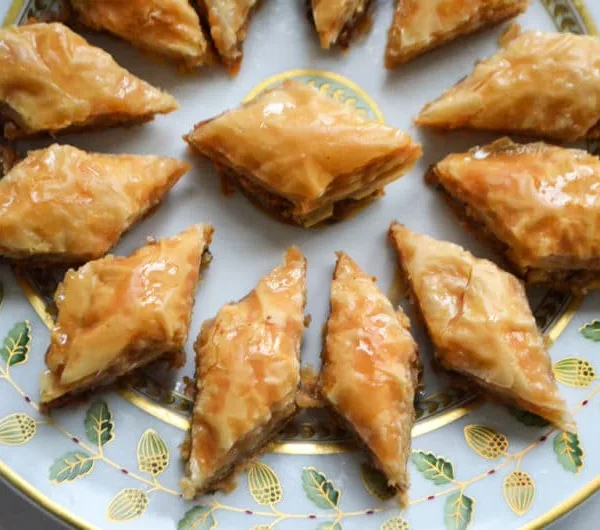
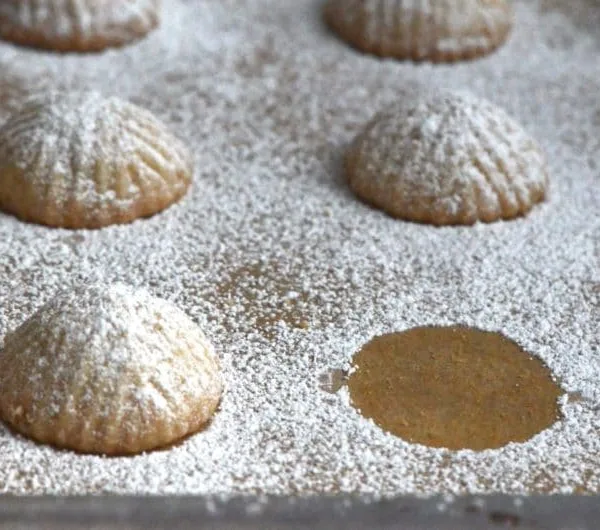
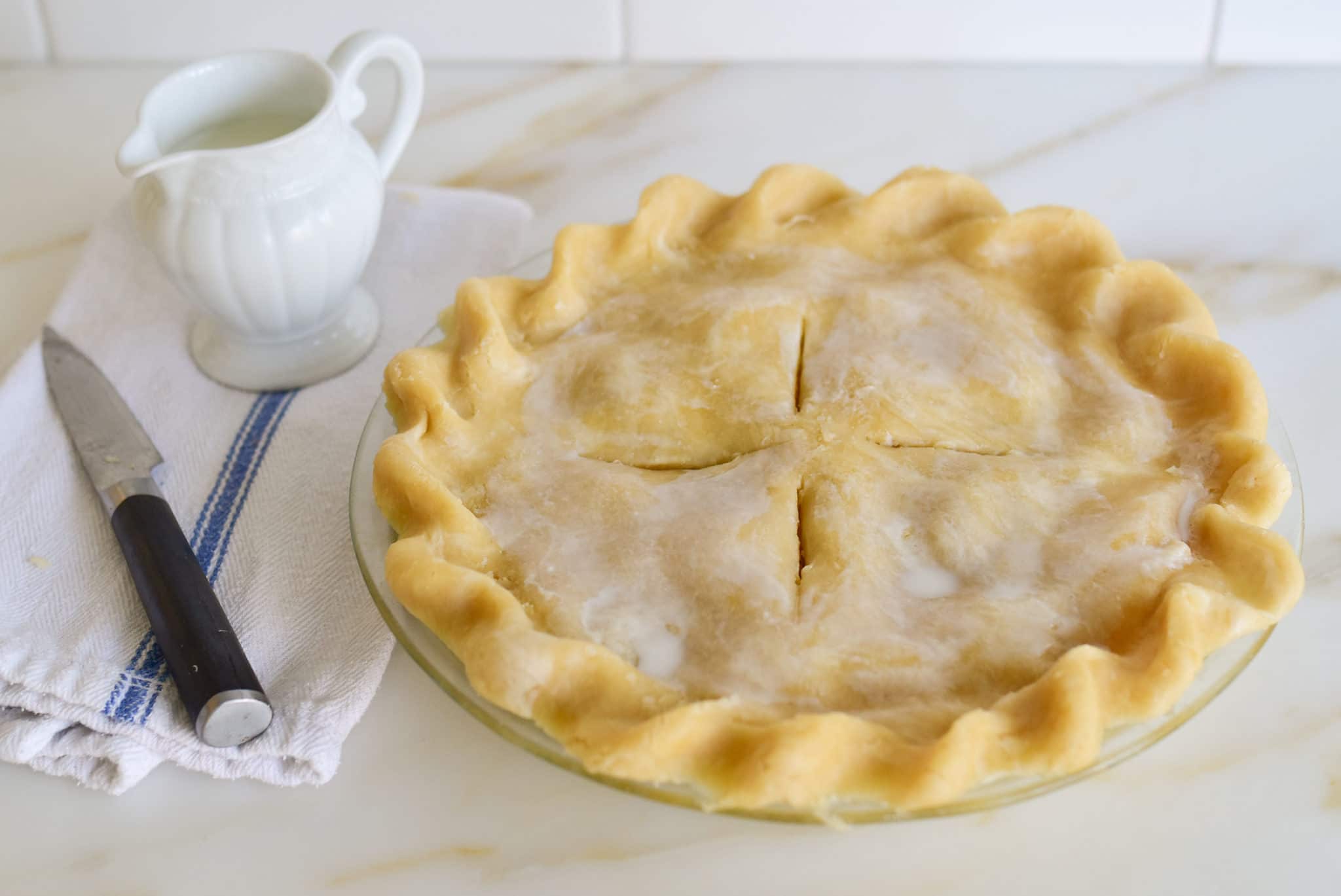
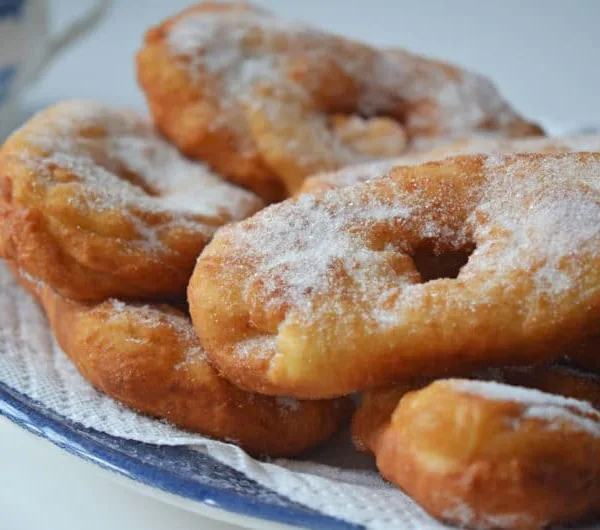







Wonderful comments!Thank you!
Thanks for getting the word out about our Christian Arab traditions, Maureen! Our family is proudly Melkite Greek Catholic, too. My mom is from Zahleh; her mom was Orthodox and her father was Melkite. My father’s dad was Melkite, and his mom was Maronite. They all used to compete in their celebrations but shared a very old tradition of adding coins to the leavened dough, wrapping it in cheesecloth, and tying it to a tree branch the night before ‘eid al Ghattas, the feast of Christ’s Baptism/Epiphany. The belief is that Christ passes these homes on this holy vigil and blesses them in a special way; the coins are distributed to remember His blessing throughout the year. In New England we had to break through the frozen dough to get at the coins the next day! Our family will be doing that on Thursday night, as we do every year. The rest of the dough is used to make sweets like zlaybiyy, ‘awayyim, and mshabbak, to share, too. Catholic and Orthodox Christians, alike, call out “Deyyim, deyyim” on that day to share the joyful news of Christ’s presentation to all the world. Deyyim, deyyim, Maureen and all!
That is beautiful Charles, thank you so much for affirming these very special Christian traditions we hold so dear and that mean much to many.
Blessings to you! Love your spirit and recipes! Can I make this zalabia dough and use it next day so my grandchildren can participate! Please let me know! May 2021 drench you with God’s love!
I’ve had Zalabia every New Year’s Day my entire life. I’ve never seen this version. But plan to try it. My mom just used bread dough and cut a bit from the bowl stretched it and fried it. Covered with butter and powdered sugar. Heaven!! She kept the oil and the dough out all day so when visitors came throughout the day she would fry them fresh. What a great memory.
I hope you like this version too Marti. The butter on the fried dough sounds divine. I’ll try it, thank you!
I have been looking for this recipe for years. My grandfather and aunts use to make this for New Years all the time.
I cant wait to make them for my family. I love keeping traditional things I had as a child, now for my children, grandchildren and great grandchildren.
They use to make something else too. Perhaps you can help me find the recipe. I believed it looked like a pancake with garbanzo beans. Maybe I am wrong with the ingredients but do you know of something like this. I miss this and all the older relatives are deceased.
Wow, you have quite a clan. They are blessed with your delicious traditions. I know there is a pancake dessert called atayef filled with cream or nuts but not sure about the garbanzo bean situation!
Most doughnuts look nothing like nuts, but yours do! I’m all for celebrating the Lord Jesus and 2020 with donuts! Peace and blessings to you and Dan!
Father Steve thank you so much! So nice to hear from you!
I just tried some at Beirut Bakery in Redford which were fabulous. I have a feeling that the dough was flavored with Mahlab (sp?) Could that be possible? If so, how much would I use in place of the cinnamon, for example?
Thanks!
Hi Barbara–yes, absolutely, you’ll often see mahlab in zalabia. You can sub it for cinnamon or use it in addition to cinnamon, about 1/4 teaspoon.
Thank you gor sharing this recipe! I had searched everywhere to find this Lebanese version, so I can’t wait to try hours. My mom and grandma rolled them into long strips and twisted them, same thing just a little different.
I made your baklava recipe over the holidays and it was so delicious!
Your twist version sounds so nice. I’m so glad to hear you enjoyed the baklawa!
Hello Maureen. I love reading your posts and trying your recipes. I’m a first generation Lebanese from Australia. I’m Orthodox but my mum is Melkite.
The zlabya and awaymet (balls) being fried in oil and dipped in syrup are representative of Christ’s baptism in the Jordan river which is also celebrated on January 6 as”Eid el-Ghtas” or theophany.
Xx
Lopitta Fares
Sydney/Beirut
Maureen, I love your blog and my family is forever grateful that I purchased your cookbook. 😉
I’ve been wondering why the syrup should be cold. Does it help it adhere better to the warm zalabia?
Thanks so much Michelle! Interesting question–we always pour cold syrup over hot pastry for baklawa, so that the syrup will properly adhere to the pastry. Here, it’s a little different since it’s a yeasted fried dough, and yet cold over hot is always done anyway. The same idea applies I suppose, so that the syrup will sink in more to the donut. We often then dip the donuts again in the syrup while eating….
I love this feast ! (And not just because we get to eat donuts)
It feels like the last of the 12 days of Christmas.
Here’s a little more about the Epiphany in the Maronite rite, if you’re interested 🙂
At midnight, on the night before the Epiphany, Maronite tradition has it that Jesus will pass over and bless the homes and that at the moment He passes all creation bows down to Him except for the cursed fig tree and the proud mulberry tree. We greet each other with the term “Deyim Deyim” which means “everlasting everlasting” and signifies that the Everlasting never forgets to visit.
On the eve of the Epiphany open all your windows and doors so that Christ can pass over your house at midnight. Stay up till midnight and bow down with the rest of Creation.
Beautiful, beautiful, beautiful!
The Epiphany also marks Christ’s baptism in the Jordan by St. John…thus the donuts that are dunked in syrup.
Also, I’ve never seen anyone actually roll the balls before…
What is Melkite and Maronite? My family are Antiochan Orthodox. My Grandmother was proud that the first Christians were from Antioch. She claimed to be from those first. Dier Mimaa has several churches but none are of the two you mention
Those are Eastern Rites of the Catholic Church.
Maureen….our Maronite church has Zalabia every Sunday after Mass and the ‘ladies’ of the church rotating who is on the Zalabia Patrol! The only difference from yours is that they make the dough into rings and then fry, add glaze and then with our without powdered sugar. Thanks for brining back such wonderful memories of home.
Georgia Hobaica Frasch
I love it!!! I want to be on Zalabia Patrol!
o, my, maureen, finally some reference to the melkite religion!
yay!
my mother was maronite, my father, also, melkite.
aren’t we the lucky ones to have both influences?
happy new year to you and dan!